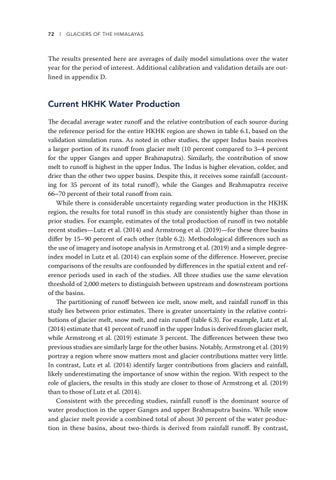72 l Glaciers of the Himalayas
The results presented here are averages of daily model simulations over the water year for the period of interest. Additional calibration and validation details are outlined in appendix D.
Current HKHK Water Production The decadal average water runoff and the relative contribution of each source during the reference period for the entire HKHK region are shown in table 6.1, based on the validation simulation runs. As noted in other studies, the upper Indus basin receives a larger portion of its runoff from glacier melt (10 percent compared to 3–4 percent for the upper Ganges and upper Brahmaputra). Similarly, the contribution of snow melt to runoff is highest in the upper Indus. The Indus is higher elevation, colder, and drier than the other two upper basins. Despite this, it receives some rainfall (accounting for 35 percent of its total runoff ), while the Ganges and Brahmaputra receive 66–70 percent of their total runoff from rain. While there is considerable uncertainty regarding water production in the HKHK region, the results for total runoff in this study are consistently higher than those in prior studies. For example, estimates of the total production of runoff in two notable recent studies—Lutz et al. (2014) and Armstrong et al. (2019)—for these three basins differ by 15–90 percent of each other (table 6.2). Methodological differences such as the use of imagery and isotope analysis in Armstrong et al. (2019) and a simple degreeindex model in Lutz et al. (2014) can explain some of the difference. However, precise comparisons of the results are confounded by differences in the spatial extent and reference periods used in each of the studies. All three studies use the same elevation threshold of 2,000 meters to distinguish between upstream and downstream portions of the basins. The partitioning of runoff between ice melt, snow melt, and rainfall runoff in this study lies between prior estimates. There is greater uncertainty in the relative contributions of glacier melt, snow melt, and rain runoff (table 6.3). For example, Lutz et al. (2014) estimate that 41 percent of runoff in the upper Indus is derived from glacier melt, while Armstrong et al. (2019) estimate 3 percent. The differences between these two previous studies are similarly large for the other basins. Notably, Armstrong et al. (2019) portray a region where snow matters most and glacier contributions matter very little. In contrast, Lutz et al. (2014) identify larger contributions from glaciers and rainfall, likely underestimating the importance of snow within the region. With respect to the role of glaciers, the results in this study are closer to those of Armstrong et al. (2019) than to those of Lutz et al. (2014). Consistent with the preceding studies, rainfall runoff is the dominant source of water production in the upper Ganges and upper Brahmaputra basins. While snow and glacier melt provide a combined total of about 30 percent of the water production in these basins, about two-thirds is derived from rainfall runoff. By contrast,




